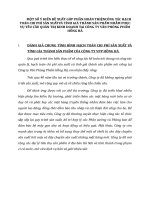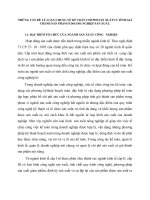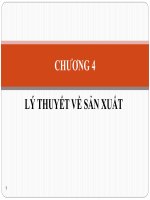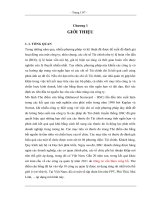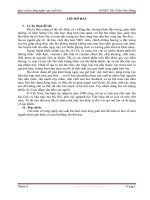Đề cương thẩm định quy trình sản xuất thuốc tiêm của FDA
Bạn đang xem bản rút gọn của tài liệu. Xem và tải ngay bản đầy đủ của tài liệu tại đây (97.18 KB, 36 trang )
Process Validation
of
Sterile Liquid Products
By
Weerayut Chirarutsami
23/08/2006
1
Process Validation
Process validation is establishing documented evidence
which demonstrate that the manufacturing process will
consistently produce a product meeting its predetermined specifications and quality Characteristics.
New Product <==> Trial Batch, Development Batch
Transferred Product <==> Products produced at the sending site
Revalidation Product <==> The original product before revalidation
2
Process Validation
Type of Process Validation
Prospective
Concurrent
Conducted prior to market the product
Based on information generated during actual
implementation of the process (each batch will be
released separately)
Retrospective (Not recommended for sterile product)
Based on accumulated historical production, testing and
control data
Generally requires data from 10-30 batches
Use data only from batches made by the same process
3
Validation of Sterile Product
Sterile Product :
The Products which free of any viable organisms.
Sterility :
Viable microorganisms are absent.
Bioburden :
Total number of viable microorganisms on or in
pharmaceutical product prior to sterilization.
4
Validation of Sterile Product
Terminal Sterilization :
Operation whereby the product is sterilized separately by
autoclave after filled and packaged using sterilized containers
and closures in critical processing zones.
Aseptic Operation:
Operation whereby the product is sterilized separately by filtering
through 0.2 µ or less filter, then filled and packaged using
sterilized containers and closures in critical processing zones.
5
Validation of Sterile Product
Validation Team: Production, QC, QA, Engineer,Planner
#
To prepare the validation protocol
#
Verify the calibration and maintenance status of equipment
#
Perform qualification for equipments and system
#
Verify change control
#
Schedule the validation activities
#
Training production operators
#
Conduct validation study
#
Monitor the critical steps in manufacturing process
#
Assure that the approved testing standard is being used
#
Evaluate all test results,
#
Prepare the validation report.
6
Validation of Sterile Product
Pre-validation Requirements :
Preventive Maintenance for Facilities and Utilities
Calibration of Equipment
Cleaning Validation
Equipment & System Qualification
Raw Materials/Components/Test Methods
Process Justification
Change Control
Training operators
All must be proven suitable and reliable for the manufacturing process
before the process can be validated
7
Validation of Sterile Product
Process Justification:
To identify critical process steps & process parameter of Mixing
process
To determine the suitable Hold time Period
To confirm the analytical tests that will have to be performed
To define the optimal parameters throughout the overall ampoule
filling process to consistently produce the finished products(filled
ampoules) which meet the established specifications.
To assure that the product is sterile after sterilization process
8
Validation of Sterile Product
Validation Protocol
A document stating how validation will be conducted,
including test parameters, product characteristics, production
equipment to be used and decision points on what
constitutes acceptable test results
9
Validation of Sterile Product
Validation Protocol should contain :
Title Page, Review/Approval Page
Purpose and Overview
Equipment List
Ingredients and Component List
Qualification List of Equipment and System
Process Flow Diagram and Description
Equipment Critical Process Parameter
Process Validation Sampling Plan/Testing Requirements
Acceptance Criteria
Stability Requirements
Process for evaluation of any deviations occurring during validation
Conclusion
10
Validation of Sterile Product
Equipment Critical Process Parameter:
Mixing Speed
Mixing Time
Gas flushing time
Type and size of filter
Filtering Time and Pressure used
Filling Speed
Temperature and Duration for Terminal Sterilization
Critical Manufacturing Step
Dissolving Step
pH adjustment step
Final mixing step
Filtering Step
Filling Step
Terminal Sterilization Step
Leak Test Step
11
Validation of Sterile Product
Critical Processing Parameter
•Mixing Speed
•Mixing Time
•Flushing Time
•pH
12
Validation of Sterile Product
Critical Processing Steps
Dissolved Active Ingredient
pH Adjustment
Final Mixing
Filtration
Filling
Sterilization
13
Validation of Sterile Product
Acceptance Criteria
Dissolved Active Ingredient
pH Adjustment
Clear Solution
pH with in specification
Final Mixing
pH, Appearance, Assay Content,
Bioburden, Holdtime
Filtration
Filter Integrity, Sterility, pH,
Holdtime
14
Validation of Sterile Product
Acceptance Criteria
Filling
Sterilization
Leak Test
Visual Inspection
Appearance, Bioburden,
Holdtime, Oxygen Headspace
Sterility, Assay, pH, Endotoxin etc.
No. of Leaked products
No. of Defected products
15
Validation of Sterile Product
Product Testing
Validation testing of bulk and F/G must be based on
testing standard release criteria and in-process testing
criteria
Typically involves non-routine sampling/testing throughout
the entire process, with special emphasis on critical
process parameters.
Routine QC release testing should be performed on a
routine sample. These samples should be taken
separately from the validation samples.
16
Validation of Sterile Product
Validation Batch:
New product and product transfer, Prospective validation is required
Manufacturing Process, Formula, Equipment and Batch Size have to
be fixed during the validation trials.
Batch Size should be the same size as commercial production batch
The batch size must be fixed for production.
Different lots but same manufacturer of active ingredients should be
used during validation trials.
17
Validation of Sterile Product
Validation Batch: Bulk Sampling and Testing
Samples may be taken by
Collecting during Transfer
Using a sampling device
Take at least 2 samples at top, middle and bottom
Individual Testing of sample must be done and the result must meet the
testing standard specification
18
Validation of Sterile Product
Qualification of Maximum Bulk Hold Time
The maximum period of time which the bulk can be held prior to
filter, Fill and/or Sterilization
It will be counted after finished final mixing step until transfer to
filter, finished filter until start filling and/or finished filling until start
sterilization
One full scale batch should be held for most practical maximum
time period prior to filter, fill and/or sterilization
If there is not enough support information / qualification done. The
period of 24 hours will be used
Hold time qualification must simulate actual storage condition
19
Validation of Sterile Product
Finish Product Testing after Sterilization
Uniformity of filled volume
Sterility
10 samples from each of the beginning and end of the filling run.
Samples must represent all filling nozzles.
Visual Evaluation
Perform testing on filled containers.
Appearance, Color of solution
Other Testing
Assay, pH, Density, Pyrogen or Endotoxin etc.
20
Validation of Sterile Product
Validation Report
¾
Validation Team must prepare the report
¾
Report must be reviewed and approved by QA.
¾
Written Notification or either successful completion or failure of the
process validation must be issued to top management.
¾
In case of failure, an investigation must be completed and documented
prior to repeat the validation study.
21
Validation of Sterile Product
Changes and Revalidation
Change of any of the following may need revalidation
Formula Composition
Raw Material Source
Manufacturing Process
Manufacturing Location
Equipments
Batch Size
Testing Specification
22
Validation of Sterile Product
Changes
Minor: It seems to have no impact on formulation
Intermediate : It could have significant impact on formulation
It is not necessary to validate
Depend on case-by-case (A minimum of 1 trial)
Major : It is likely to have significant impact on formulation
Revalidation is required (A minimum of 3 trials)
23
Validation of Sterile Product
Minor Change
Qualitative inactive excipient change deemed minor by
change control review
Process change deemed minor by change control
review
Manufacturing location change with in same building,
same equipment, personnel, procedure and utilities are
used
Equipment change but same design, configuration
24
Validation of Sterile Product
Intermediate Change
Active ingredient source or synthesis change deemed
intermediate by change control review
Qualitative inactive excipient change deemed intermediate by
change control review
Manufacturing location change to a different building on the
same site and same utilities, same equipment, personnel, and
procedure are used
25

